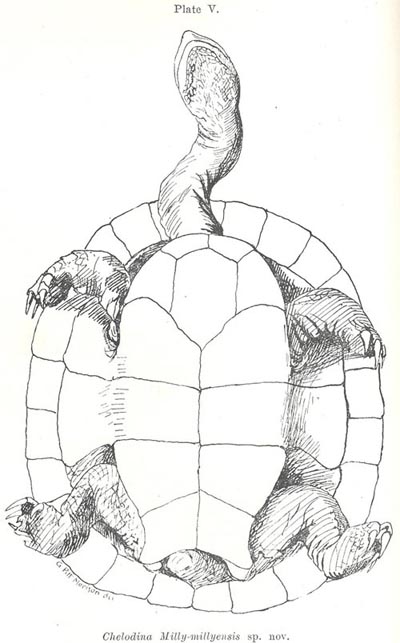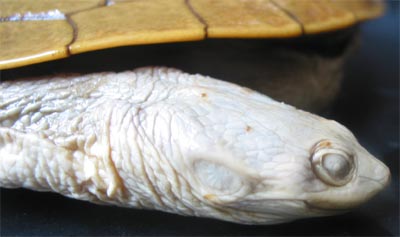Steindachner's Snake-necked Turtle -- Chelodina steindachneri
[3]
 The Long-necked Tortoises (genus Chelodina), whose range is confined to the Australian region, have the neck longer than the dorsal vertebral column; no barbells on the chin; carapace with (normally) five vertebral plates, four pairs of costals, a marginal nuchal, and a pair of pygals; plastron with an intergular not reaching the margin, and six pairs of plates (The Animals of Australia, Lucas and Le Souef). The extremely long neck and very short tail, as well as the position of the intergular plate, distinguish this genus from the other Australian fresh water tortoises - Emydura and Elseya.
The Long-necked Tortoises (genus Chelodina), whose range is confined to the Australian region, have the neck longer than the dorsal vertebral column; no barbells on the chin; carapace with (normally) five vertebral plates, four pairs of costals, a marginal nuchal, and a pair of pygals; plastron with an intergular not reaching the margin, and six pairs of plates (The Animals of Australia, Lucas and Le Souef). The extremely long neck and very short tail, as well as the position of the intergular plate, distinguish this genus from the other Australian fresh water tortoises - Emydura and Elseya.
The four specimens R911, R912, R1000, and R1106, show remarkably slight variation in the proportions and arrangements of the horny plates, differing in this respect from the south-western Chelodina oblonga, in which no two specimens are even approximately alike.
The carapace is depressed, elliptical, slightly broaded behind, with indication of a broad shallow depression along the vertebral region; nuchal shield smaller than the marginals, much longer than broad, first vertebral shield longer and broad than the rest, fourth not shorter than the third, but narrower than the other members of the series, fifth both longer and wider than the second, third and fourth. Plastron about twice as long as wide, feebly angulated laterally, its greatest width in front of the bridge, considerable shorter and narrower than the carapace, the posterior notch which is angular in young forms tends to lose its sharpness in the adult; intergular longer than the pectorals or the femorals, fully twice as long as the suture between the pectorals; suture between the annals longer than that between the femorals.
Photo: Drawing of Chelodina steindachneri by Pitt Morison featured in Glauert 1922
Head, neck, and limbs as figured, neck and sides of head tubercular. Digits broadly webbed, a series of transverse lamellae on the upper surface of the fore limb and on the lower surface of the hind limb.
Dark olive-brown above, plastron and lower surface of marginals yellowish; the younger specimens have narrow dark brown margins to the sutures on the under surface as in Chelodina longicollis, but these markings are quite absent on the larger specimen, R1000. The general colour of the soft parts in the living animal is dark olive brown above and cream below. After death the colours fade.
The new species resembles Chelodina expansa in the shape of its carapace and plastron, but differs from it in the proportions of the shields on the plastron. On the other hand it resembles Chelodina novae-guineae in the shape of the plastron and proportions of its shields, but differs in the shape of the carapace. Apparently there are no transverse lamellae on the under surface of the hind limb of C. expansa or C. novae-guineae.
Measurements of carapace, length 212 mm., breadth 184 mm.
Habitat.-Freshwater pools and creeks, Milly Milly, Murchison River, W.A.
The name proposed for the new form, Chelodina milly-millyensis, is suggested by the locality where specimens were obtained.
I am indebted to my colleague, Mr. G. Pitt Morison, for the excellent drawings illustrating in this paper.
-----
As it is obvious from the text above, Glauert (1922) desribed the same Chelodina species as did Siebenrock in 1914 and, therefore, the name Chelodina steindachneri is considered the senior synonym.
Bottom photo: Head view of the holotype of Chelodina steindachneri (N.M.W. 19798)
 Etymology
Etymology
This species was named in honour of Dr Franz Steindachner (1834-1919), the director of the Museum of Natural History in Vienna, an Austrian ichtiologist and herpetologist who gave four specimens of C. steindachneri to the famous Austrian naturalist Dr Friedrich Siebenrock (1853-1925) who then described the species. Being named after a person, the gender of the species epithet overrules the gender of the genus and thus is masculine.
The common names of the species include Flat-shelled Turtle, Steindachner's Snake-necked Turtle or Dinner-plate Tortoise.
Morphology
This Chelodina species has a great morphological variation between different areas. (Cann 1998) It is the smallest Australian long-necked Chelid. The carapace is flat, wide, depressed and smooth. There is a shallow depression running along the vertebral region. (Siebenrock, 1914; Glauert, 1922) A thin cervical scute is present with twelve marginals including supracaudals on each side of the caparace. The side marginals show signs of turning up and a small indication of the rear marginal flaring exists, with a slight raising of the two anal marginals. (Cann, 1998). The first vertebral shield is wider than rest (Siebenrock, 1914; Glauert, 1922) - one of the Chelodina characters.
